Last Updated on: October 7, 2024
With the abundance of unique and nature-focused activities in the Midwest, do you ever wonder what Wisconsin woodpeckers you might encounter in the area?
For generations, the woodpecker has been a charismatic bird that fascinates the human imagination. Nowadays, more and more people see watching these creatures as a rewarding pursuit that anyone can enjoy anywhere.
Hence…
Let’s learn more about these woodpeckers of Wisconsin you get to see in your backyard or the wilderness. Discover better ways to identify each species with their songs, appearances, feeding habits, migration, and interaction with us all.
The Diversity of Woodpecker Species in Wisconsin
Birders never run out of the spectacular view of various woodpecker species around Wisconsin. Every enthusiast gets their share of filling their backyard feeders for these wild birds in winter.
Despite other woodpeckers not a native to the region, you still get an extreme pleasure of what some might call a rare sighting.
Some of these woodpeckers of Wisconsin are easier to observe, while others are not as plentiful in the area. Occasionally, you’ll glimpse these exciting birds in the suet feeders in your backyard.
None of these things are surprising, with the abundance of rivers and streams, evergreen forests, and rocky shores in the area. Wisconsin has so much to offer, habitats for our feathered friends, and birdwatching opportunities for every naturalist or bird lover worldwide.
The following are the familiar woodpecker species you can encounter throughout the state:
1. Downy Woodpecker

The downy woodpecker is among the Wisconsin resident birds you will see year-round throughout the state due to its broad distribution. These birds generally sport a black and white plumage similar to hairy woodpeckers, so many would confuse one with the other.
The male downy woodpeckers show a white stomach and white spots adorning their black wings. These male downies also have a distinct red patch on the back of their heads, white stripes down their backs, and black-spotted white tail feathers.
Female downy woodpeckers share an identical look except for the red coloring on the male’s head. The stiff tail feathers allow a downy woodpecker to brace tree trunks like a tripod.
A downy woodpecker prefers nesting in tree cavities with round entrance holes.
Both sexes excavate these cavities about eight to eighteen inches deep in most living or dead trees, sometimes in dead timber stumps or fenceposts. You will notice that such nests belonging to downy woodpeckers are often placed ten to thirty feet above the ground.
A female downy woodpecker typically lays three to five white eggs without markings, incubating in the daytime for the next eleven or twelve days. These creatures are non-migrating species, primarily feeding insects but readily eat suet, sunflower seeds, and peanuts at bird feeders.
Throughout the year downy woodpecker is visible in Wisconsin’s boreal or hardwood forests, inhabiting farmsteads, orchards, and urban areas. Like most woodpeckers, downy woodpeckers are widespread where trees are abundant.
Furthermore, such creatures bear these long, barbed tongues for catching insects from even the tiniest, hard-to-reach spots. Thus, it’s not surprising to see downy woodpeckers exploiting hummingbird feeders too.
2. Yellow-Bellied Sapsucker
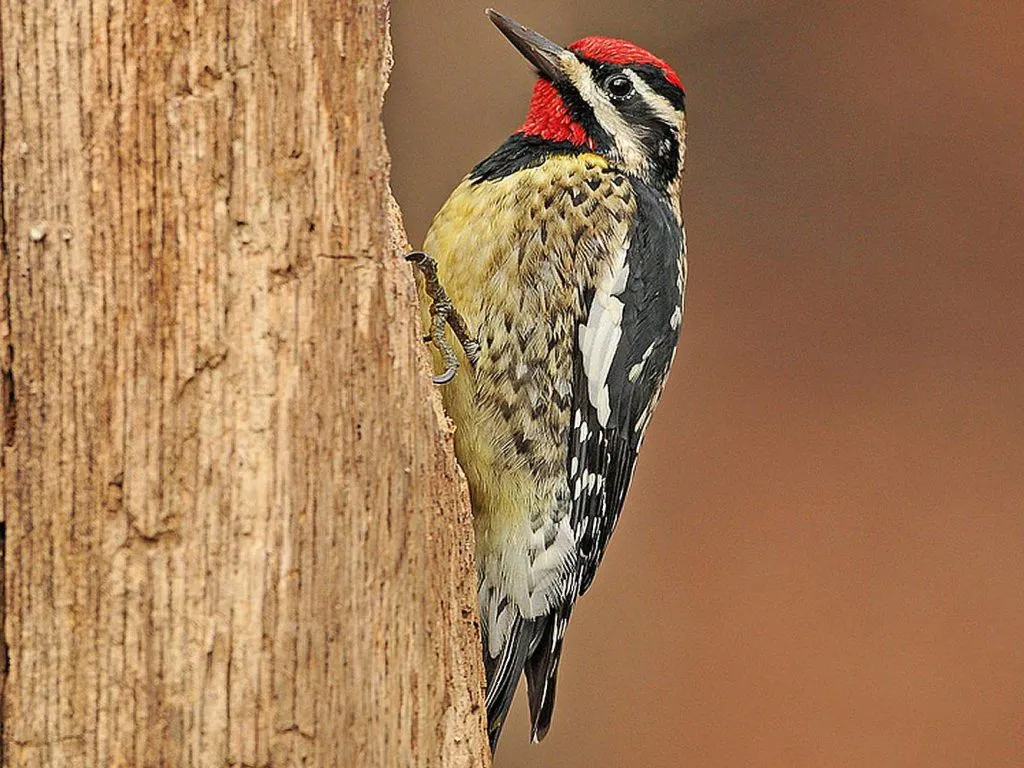
When looking for the yellow-bellied sapsucker, keep a watchful eye when trailing the central region’s forested section of the Big Creek State Fishery Area.
It also frequents Bubolz Nature Preserve, still from central Wisconsin, and the grasslands and marshes of the American Legion State Forest in the northern region.
Despite its extensive range throughout the state, sightings of yellow-bellied sapsuckers are unusual in central and southwest Wisconsin during the warmer months. By contrast, the bird rarely graces southern Wisconsin with its presence in the colder months.
You will recognize a male yellow-bellied sapsucker with its patterned face in black and white plumage, a solid black stripe bordering its red throat patches.
Instead of red, female yellow-bellied sapsuckers sport a white throat, while both sexes display bright red heads and bold white napes. You will notice that the birds’ bright white patches are more prominent during flight.
Male and female create their nest three to thirty-five feet from the ground in live aspen trees, where the female lays four to six eggs. Tree sap and insects attract a yellow-bellied sapsucker, drilling horizontal holes in trees to bleed sap that lures bugs, consuming it aside from the juice.
Likewise, it eats cracked walnuts, suet, and peanuts in bird feeders; these woodpeckers also enjoy drinking from nectar feeders.
Aside from its preference for aspen and young deciduous forests, you may also see this sapsucker in orchards, woodlands, farmlands, and parks during migration.
3. Pileated Woodpecker
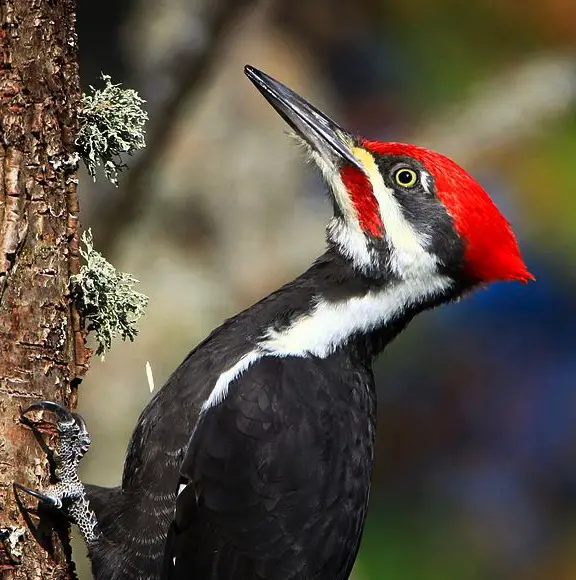
The Pileated is among the largest woodpeckers in Wisconsin next to the ivory-billed woodpecker, measuring about eighteen inches. It is a year-round woodpecker in Wisconsin with black overall, bright red crests, and black and white stripes from its face to the neck.
Unlike other woodpecker species, pileated woodpeckers are well-known for their excellent tree-climbing skills. Despite a shorter middle toe than its claw, this expert clings easily on tree trunks in nearly any position while drilling incessantly for ant colonies.
A pileated woodpecker has a prevalent population throughout the state, although it is more familiar in northcentral and southwest regions. Male pileated woodpeckers are about the same size as the crows and have black-colored backs.
These birds’ foreheads, crests, and mustaches display a vivid shade of red; female pileated woodpeckers have their crests close to a brownish shade than red. Moreover, the females lack the red mustache and sport a black forehead.
Such birds also show significant white shade on their underwings during flight. Like most woodpeckers, male and female pileated woodpeckers excavate their nest on large trees about sixteen inches in diameter and twenty-five feet from the ground.
Carpenter ants, wood-boring beetles, acorns, wild fruits, and sumac seeds are among the preferred meals of a pileated woodpecker. Nonetheless, you can attract woodpeckers such as the pileated to backyard bird feeders with suet and peanuts and some nest boxes too.
Also, if you wish to spot the pileated woodpecker effortlessly, look out for it in mature forests with hardwood trees near lakes and rivers.
4. Hairy Woodpecker
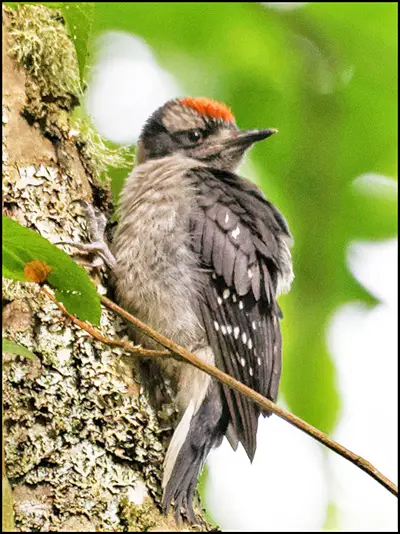
Hairy woodpeckers are generally three inches larger than their look-alike, the downy woodpecker. These two woodpeckers in Wisconsin are both year-round residents and look so much alike that many people have difficulty telling them apart.
Both species bear a broad white marking on their back and black wings, highlighting the white spots. Male hairy woodpeckers also have a red patch on the back of their heads; their underparts are white and black tails have white outer tail feathers.
Experienced birders consider the bill length relative to head size as the most reliable identifier between these two birds.
The hairy woodpecker prefers to build its nest in dead or living trees so long as it has decayed heartwood. Likewise, the bird likes to have its nest at least five to thirty feet from the ground.
This non-migrator loves eating beetle larvae, fruits, and nuts; attracting woodpeckers such as the hairies to backyard feeders is also possible. All you need are feeders full of black oil sunflower seeds, cracked almonds, and suet to have a hairy woodpecker visit your space.
The hairy woodpecker is a common inhabitant of mixed forests, such as hardwood and coniferous forests, urban areas, and swamps. The bird’s affinity for wood-boring beetle larvae makes the hairy woodpecker a natural pest controller of destructive forest insects.
5. Red-Headed Woodpecker

The Storrs Lake and Lima Marsh State Wildlife Areas are close to oak woodlots, which is why they draw many red-headed woodpeckers. Those places would be the best to visit if you’d like a close encounter with this species.
The red-headed woodpecker measures eight inches long and, unlike the other birds of its kind, has an entirely scarlet head.
Its underparts from the breast are white with mainly black and white back and wings. Red-headed woodpeckers are more prevalent during summer, although you can still see them in certain areas in the state, especially during the breeding season.
The male red-headed woodpecker excavates tree cavities about twenty to thirty feet from the ground; sometimes, it builds a nest in fence posts. Both sexes incubate for a period ranging from twelve to thirteen days approximately.
Red-headed woodpeckers are also partial migrants depending on food supply availability. These birds mainly eat insects such as beetle larvae, nuts, and fruits but also visit feeding stations for suet and sunflower seeds.
The red-headed woodpecker typically frequents mature oak woodlots, open woodlands, orchards, and mixed hardwood forests.
6. Red-Bellied Woodpecker
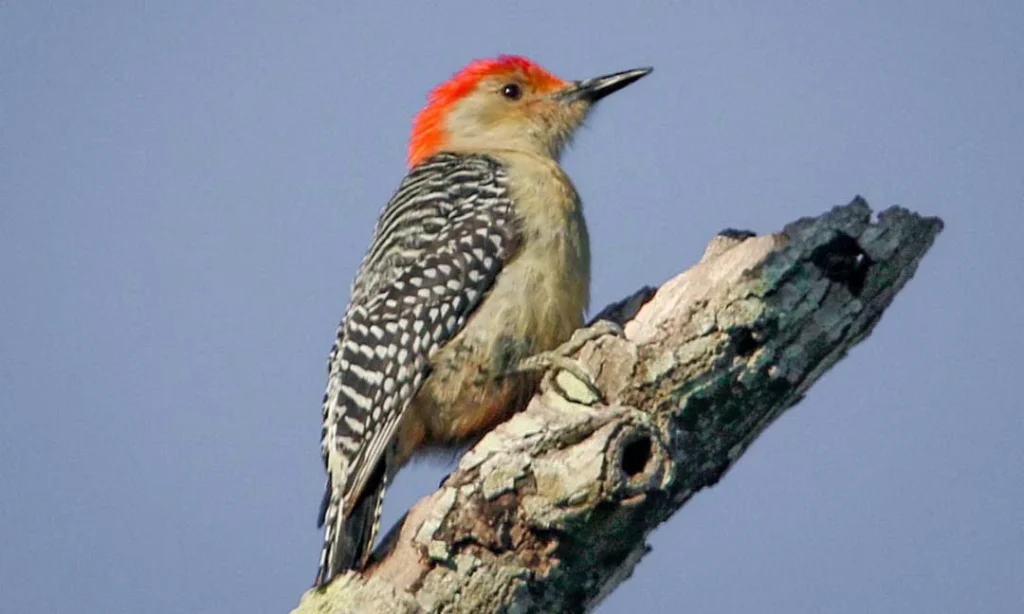
Red-bellied woodpeckers are signature species in central Wisconsin’s 275-acre Schmeeckle Reserve and Ledge View County Park and Nature Center.
The abundance of mixed forests, preferably coniferous and deciduous, wetlands and streams lure the red-bellied woodpecker and other species around these areas.
Such woodpeckers and some other birds also occur in the southern section of the Kettle Moraine State Forest. The red-bellied woodpeckers, also well-known as the zebra bird, are among the medium sized woodpeckers with an undulated flight pattern.
The bird features a heavily barred back in black and white, with a subtle blush shade on its belly. Female red bellied woodpeckers sport a red nape and a brownish-gray head. Furthermore, the red bellied woodpecker is also a cavity nester, typically in maple, birch, and apple trees.
Like the other species, such a bird is also fond of consuming wood-boring beetles. It occasionally eats acorns, orange halves, wild fruits, shelled corn, and sunflower seeds.
7. Northern Flicker
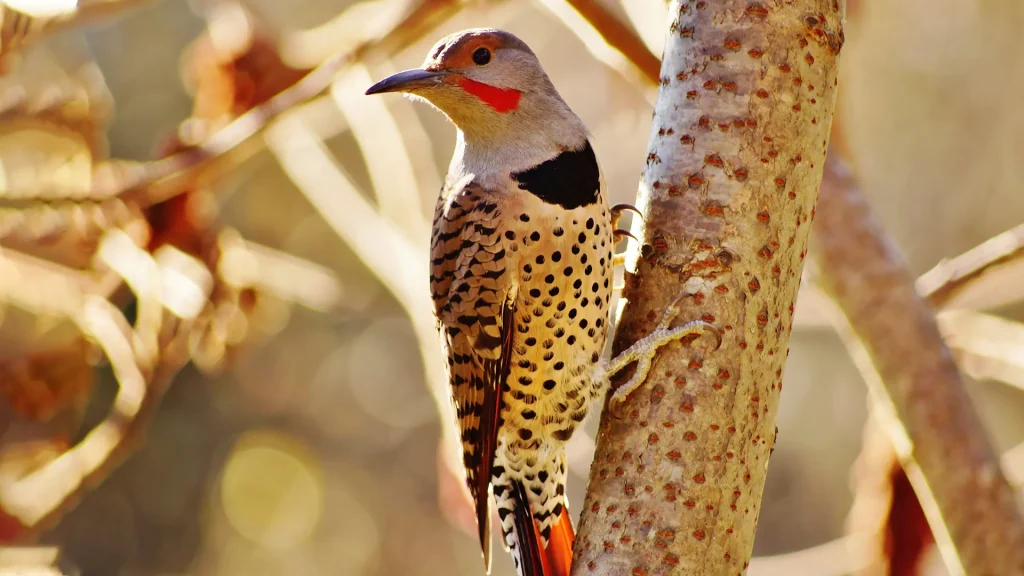
The oak woods in Big Foot Beach State Park is a habitat for the northern flicker and some other birds, like the American robins.
Northern flickers are also signature species in central Wisconsin’s La Crosse River State Fishery Area.
The male northern flicker is easily recognizable with its brown and black overall, black mustache extending to the neck, speckled chest, and red nape. On the contrary, female northern flickers look the same except for the black mustache.
Such a bird is the only woodpecker that mainly feeds on the ground, foraging for its favorite meals, ants, and beetles. Besides its affinity for insects, you may also expect a northern flicker to feed on wild berries, acorns, hackberry seeds, and corn when visiting backyard feeders.
Otherwise, northern flickers often frequent an open woodland, predominantly deciduous and coniferous forests, urban backyards, and savannas.
Rare Woodpeckers Of Wisconsin
Black-backed woodpeckers are rare in Wisconsin, as much as the American three toed woodpeckers. A black-backed woodpecker inhabits upland forests, wetlands, and boreal habitats, while the American three-toed woodpecker is trickier to locate.
It’s pretty understandable due to the black-backed woodpecker scarcity in the state; even the woodpecker with three toes rarely breeds in Wisconsin.
If you’re wondering about these two rarities, these two species are the first woodpeckers to benefit from food supplies from newly burned forests. Both woodpeckers forage adult beetles looming from the burned trees.
The American three-toed woodpecker looks like the Arctic three-toed woodpecker except for the white-barred back, lacking in the latter species. The bird’s primarily black with a bright yellow cap and white outer tail feathers.
Black-backed woodpeckers look similar to the preceding species, but these birds’ most prominent similarity is their three toes. American three-toed woodpeckers heavily rely on wood boring beetle, as much as black-backed woodpeckers depend on larval bark beetles.
Watch This!
Frequently Asked Questions
Does the law prohibit shooting woodpeckers in Wisconsin?
Most of us are aware of the damages to properties and livelihood that woodpeckers cause sometimes. The best way to deal with such nuisance is to take action as soon as possible.
But when these birds get too close for comfort, know the provisions of the Migratory Bird Treaty Act first. Research the protected woodpecker species in your area before taking drastic measures if all other methods to deal with woodpecker damages fail.
Are red-headed woodpeckers rare species in Wisconsin?
Despite many individuals confusing the red-headed woodpecker with the red bellied woodpecker, it is an enchanting sight around Wisconsin. Unless you see these birds up close, you will likely miss the rosy shade in the underparts of red bellied woodpeckers.
Overall, such a species is not rare in Wisconsin, but you will hardly encounter its kind in winter. Nonetheless, the black-backed woodpecker and American three-toed woodpecker are rare species in the area.
Do woodpeckers in Wisconsin overstay in winter?
The state is well-known for its frigid winter as much as it is famous for its steamy summer. Several Wisconsin woodpeckers are non-migrating species, and you can expect to continue seeing them even through the colder months.
For starters, you are more likely to encounter downy and hairy woodpeckers wintering in central Wisconsin. Even red bellied woodpeckers will appreciate it if you maintain well-stocked bird feeders, preferably with suet, along the eastern regions of the state.
Conclusion
Woodpeckers might have this ill reputation of being destructive to several homeowners around the state. Sometimes these birds’ stunning appeal makes up for the damages they cause, and sometimes not. Nevertheless, these creatures never fail to cause excitement in people. Some even anticipate their presence as they flock to the suet feeders in most backyards.
May all your insights about these woodpeckers spark more interest in their conservation. Or better yet, may we become more committed to protecting our wildlife for the coming generations of future birdwatchers.

